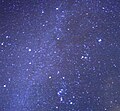Orionids
| Orionids (ORI) | ||
|---|---|---|
Zenithal hourly rate 20[5] | | |
The Orionids meteor shower, often shortened to the Orionids, is one of two meteor showers associated with Halley's Comet. The Orionids are so-called because the point they appear to come from, called the radiant, lies in the constellation Orion, but they can be seen over a large area of the sky. The Orionids are an annual meteor shower which last approximately one week in late October. In some years, meteors may occur at rates of 50–70 per hour.[6][7]
Orionid outbursts occurred in 585, 930, 1436, 1439, 1465, and 1623.
History
Meteor showers first designated "shooting stars" were connected to comets in the 1800s. E.C. Herrick made an observation in 1839 and 1840 about the activity present in the October night skies. A. S. Herschel produced the first documented record that gave accurate forecasts for the next meteor shower.
The meteor shower
An outburst with a zenithal hourly rate of 100+ occurred on 21 October 2006 as a result of Earth passing through the 1266 BCE, 1198 BCE, and 911 BCE meteoroid streams.[12] In 2015, the meteor shower peaked on October 26.[13]
| Year | Activity Date Range | Peak Date | ZHRmax
|
|---|---|---|---|
| 1839 | October 8–15[9] | ||
| 1864 | October 18–20[9] | ||
| 1936 | October 19[12] | ||
| 1981 | October 18–21[9] | October 23 | 20 |
| 1984 | October 21–24[9] | October 21–24 | (flat maximum) |
| 2006 | October 2 — November 7[9][14] | October 21–24[14][15] | 100+[12] |
| 2007 | October 20–24[16] | October 21 (predicted)[16] | 70[17] |
| 2008 | October 15–29[18] | October 20–22 (predicted)[18] | 39 |
| 2009 | October 18–25 [9] | October 22[19] | 45[19] |
| 2010 | October 23 | 38 | |
| 2011 | October 22 | 33 | |
| 2012 | October 2 — November 7 | October 20 and October 23 | 43[20] |
| 2013 | October 22 | ~30[21] | |
| 2014 | October 2 — November 7 | October 21 | 28 |
| 2015 | October 2 — November 7 | October 26 | 37 |
| 2016 | October 2 — November 7 | October 21[22] | 84[13] |
| 2017 | October 21 | 55 | |
| 2018 | October 21 | 58 | |
| 2019 | October 22 | 40 | |
| 2020 | October 22 | 36 | |
| 2021 | October 21 | 41 | |
| 2022 | October 22 | 38 | |
| 2023 | October 21 | 48[13] |
* This meteor shower may give double peaks as well as plateaus, and time periods of flat maxima lasting several days.[9]
The radiant of the Orionids is located between the constellations Orion and Gemini (in the southeastern sky before dawn, as viewed from mid-northern latitudes.[9]
Gallery
-
An Orionid near the center.
-
Afish-eyeview.
-
Two Orionids and the Milky Way.
-
A multicolored Orionid.
-
An Orionid to the left.
-
The brightest meteor, a fireball, leaves a persistent smoky trail drifting in high-altitude winds, which is seen on the right side of the image.
See also
References
- ^ a b c d e Robert Lunsford (2023-10-09). "Viewing the Orionid Meteor Shower in 2023". International Meteor Organization (IMO). Retrieved 2023-10-14. (JPG)
- ISBN 0521853494.
- ^ a b c d "2023 Meteor Shower List". American Meteor Society (AMS). Retrieved 2023-09-10.
- .
- ISBN 978-0387784182.
- ^ "IMO Meteor Shower Calendar 2009". The International Meteor Organization. 1997–2009. Retrieved 2009-10-22.
- ^ "Orionids Meteor Shower Lights Up the Sky". PhysOrg.com. 2003–2009. Retrieved 2009-10-21.
- ^ .
- ^ a b c d e f g h i "Orionid". Observing the Orionids. Meteor Showers Online. Archived from the original on 2018-07-11. Retrieved 2009-10-21.
- ^ Phillips, Dr. Tony (2009-10-19). "NASA – The 2009 Orionid Meteor Shower". NASA. Archived from the original on 2009-10-22. Retrieved 2009-10-19.
- ^ .
- ^ a b c MeteorFlux 2.3 (Select Shower: ORI, uncheck "Use temporary database", select year (such as 2016) and click "Create graph")
- ^ a b "October to December 2006". The International Meteor Organization –. 1997–2007. Archived from the original on 2009-11-02. Retrieved 2009-10-22.
- ^ Stone, Wes. "2006 Orionid Meteor Shower Surprise!" (PDF). Sky tour. Retrieved 2009-10-22.
- ^ a b Handwerk, Brian (October 17, 2009). ""Old Faithful" Orionid Meteor Shower Peaks This Weekend". r National Geographic News. Archived from the original on October 19, 2007. Retrieved 2009-10-22.
- ^ Orionids 2007: visual data quicklook. imo.net
- ^ a b "Orionids Meteor Shower 2008 of October". Meteor. October 15, 2008. Retrieved 2009-10-21.
- ^ a b Orionids 2009. imo.net
- ^ Orionids 2012: visual data quicklook. imo.net
- ^ "2013 Orionids Radio results". RMOB. Retrieved 2014-08-13.
- ^ "Look for Orionid meteors this month | Astronomy Essentials". EarthSky. Retrieved 2017-10-16.
External links
- MeteorFlux 2.1 Realtime Viewer: ORI (International Meteor Organization)
- Orionids Peak This Weekend (Carl Hergenrother : 2012 Oct 20)
- Orionids 2012: visual data quicklook (web archive of International Meteor Organization)
- Spaceweather.com: 2009 Orionid Meteor Shower photo gallery: Page 1
- Orionids at Constellation Guide







